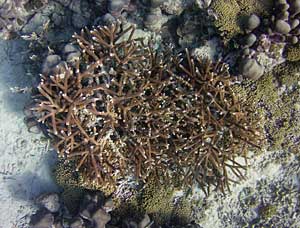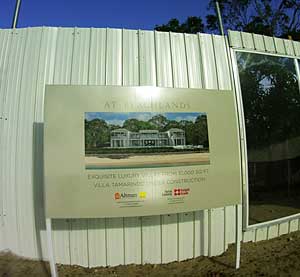I was especially fortunate in early 2015 to spend three months in Barbados. In the 1960s, I spent three years in Barbados conducting research for a graduate degree in Marine Biology and have visited the island a number of times since, but this was the first extended visit for over 20 years.
Fortuitously, the nearest beach to my residence lay on a currently undeveloped strip of land abutting on the Recreational Zone of Barbados' Folkestone Marine Reserve. Donning a mask and snorkel, I was pleased to find the outer zones of the fringing reef in this areaknown as Vauxhall to be as healthy as those of reefs just up the coast that I had explored in the 1960s. Further, the Vauxhall reef as a whole supported an abundance and diversity of fishes much greater than I had viewed in the 1960s; not a surprise as fishing has been banned in this area following its designation as a MPA (Marine Protected Area) in 1981.
However, very much to my surprise, I found recently established colonies of three species of acroporoid corals, including the elkhorn coral (Acropora palmata), staghorn coral (Acropora cervicornis) and the fused staghorn coral (Acropora prolifera). A. palmata was largely eliminated from the west coast of Barbados by the 1950s due to sedimentation. A. cervicornis remained abundant until the 1980s when a disease of all three acroporoid corals swept though the Caribbean. Only in recent years has A. prolifera, a hybrid between A. palmata and A. cervicornis, become abundant anywhere. So this seemed to be a very encouraging development. (I reported my observations to government and academic scientists in Barbados.)
Further explorations revealed, however, that fringing reefs elsewhere in the Folkestone Marine Reserve are highly degraded, even in comparison to my views of them in visits 10 to 15 years ago. So this little area of fringing reef in the Recreational Zone seems to be very special.
It is also one of the most popular snorkeling sites in Barbados, hundreds of visitors embarking each day during high season from tour boats that moor by a wreck lying just offshore in about 25 feet of water. The wreck was placed there in 1985 to create habitat for fish and corals and other creatures and to provide a focal point for snorkelers. Tour operators throw a little food in the water and it swarms with large chub and the yellow striped sergeant majors. Snorkelers are typically taken on a short excursion over the outer zones of the fringing reef, which are the ones in good health... they cannot but leave with a good impression!
I would be tremendously encouraged about the trajectory of this site, were it not for two large developments underway or scheduled to get underway on the shore. Unless extraordinary precautions are taken to ensure these developments do not disturb the nearshore environment, I cannot see how this small gem of a reef can survive as such.
I hope that that these photos and the accompanying descriptive comments will help to raise awareness of the inherent value and the commercial value of the Recreational Zone Reef, and its fragility. I also want to acknowledge and express gratitude for the efforts involved in establishing and maintaining the Folkestone Marine Reserve.
The original high resolution versions of the photos can be downloaded. I encourage use of these photos for educational purposes, and nature oriented advocacy under the conditions of a Creative Commons License.
I welcome feedback. Please send that to David.PatriquinATdal.ca
David G. Patriquin
Professor of Biology, Dalhousie University (retired)
March 21, 2015. Updated April 25, 2015.
PS 2016
I returned to this site in March of 2016. I am happy to report that the very healthy sections of the reef I observed in 2015 remained healthy in 2016. Likewise, the diversity and abundance of fishes and other life I had observed in 2015 continued into 2016 and there were new colonies of Acropora prolifera.
One change in 2016: immediately onshore, construction of the first of five large luxury villas that are being developed along this section of coast was well underway. The developers appear to be taking appropriate precautions not to disturb the beach and beyond physically. I have written them to highlight the special nature of the the reef and to encourage them to dispose of effluents in a way that avoids negative impacts on the reef. I am particularly concerned about disposal of swimming pool water containing algicides and chlorine. Perhaps it all goes into the piped sewage system and is not an issue, but it would be nice to know. (They have not replied.)
Another threat: rod and reel fishing in the recerational zone. I found fishing line snagged in several colonies of Acropora prolifera. There are no signs in the area to advise visitors that there is no fishing in the MPA.
A couple of significant, positive, developments otherwise:
First, a report on the status of Acroporoids on the west coast of Barbados was issued early in 2016: CERMES Technical Report No 80
Mapping the return of acroporid corals on fringing reefs along the west coast of Barbados
R. MACLEAN AND H.A. OXENFORD
I am quite encouraged by this report which documents over 700 individual colonies of Acropora palmata or A. prolifera on the west coast. It acknowledges the documentation on this website of A. prolifera and A. cervicornis in the recreational zone and confirms my ID of A. prolifera. Interestingly, my report of A. cervicornis in the Recreational Zone of the MPA is apparently the only documented current occurrence of A. cervicornis in Barbados to date. However the authors identified putative A. prolifera at other sites, so A. cervicornis (one parent of the hybrid A. prolifera) may well be present elsewhere in the deeper areas which were not formally surveyed.
Second, under the leadership of Susan Mahon at the Bellairs Research Institute, "A Coral Reef Restoration Alliance (CORALL) has now been formally established in Barbados. The purpose of the Alliance is:
To Foster Conservation and Restoration of Coral Reef Ecosystems in Barbados for the Well-Being of All.
The project is described as a Public-Private Partnership. A new coral regeneration program hosted by the Bellairs Research Institute is a key component.
I look forward to some more good news when I (hopefully) return to Barbados in early 2017.
- David P
23 March 2016
Updated 10 May, 2016
UPDATE March 9, 2019
I conducted a survey of all A. prolifera colonies in early February, 2019, with GPS locations for each. Overall, the population is looking very healthy, the adjacent Beachlands development apparently having no negative impacts.
I have yet to make comparisons colony by colony, but for one comparison 2019/2015, I calculated an average growth rate of approx 3 cm/year.
I noted A. palmata at 3 locations in 2019. I have yet to compare these with older observations; at least one of the colonies is a new one to me. I checked the deeper water location of A.cervicornis, and all appears well there also.
I have set up a "Project" on iNaturalist for reporting past and ongoing observations on A. prolifera: Acropora prolifera on Barbados fringing reef
One odd observation. Padina sanctae-crucis, a leafy seaweed that was common on rock surfaces nearshore, completely disapparred between 2018 and 2019 in the Vauxhall Reef area. Also, I could not find it on comparable habitats approx 1 km to the north and 1/2 km to the south, but it is still present at Bath on the east coast. NOTE Mar 19, 2019: I am starting to see scattered small plants amongst the "turf", noticeably larger by Mar 24, 2019.
On Mar 7 and 8, 2019, I guided a group of McGill students through the area with A. prolifera, and an adjacent reef flat to to the north to look at possibilites for establishing A. prolifera in a new area using transplant techniques. This is a project organized by Susan Mahon of CORALL. I was delighted to introduce these students to reefs not far from my own introduction to them in 1966, also as a McGill student.* I very much appreciate this CORALL initiative.
*My guide in those days: J.B. Lewis, the founding director of the Bellairs Research Institute. I attended a memorial event for J.B., who passed away in 2017, at McGill last summer. He would definitely be very pleased with the CORALL initiative. Talking to the McGill students, I described the reef referring to the zones he described those many years ago.
|

Staghorn coral (above), which was killed off by disease in the 1980s, appears to be making a comeback in deeper water in the area of Vauxhall, while the fused staghorn coral has appeared in the shallow, Reef Crest area of the Vauxhall finging reef.
|
Coordinates for Site: 13.179837, -59.640532
Photos were taken with a Sealife MicroHD or an Olympus Tough TG3 in an Olympus PT-052 Underwater Housing. My last proper underwater camera was a Nikonos II which I used in these waters in the late 1960s. Later on I will add some pics from that era before the onset of coral bleaching and a plethora of novel diseases and other disturbances.

|